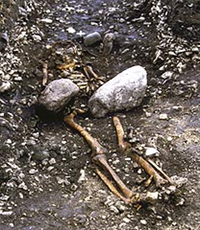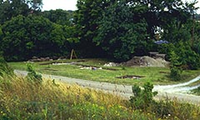Just below Fröjel church in the western part of Gotland and close to the ancient coastline, one of the largest and most important trading places on Gotland during the Viking era is to be found. It was well-sheltered from hard winds by the island just beyond and the site was seething of activity over a period of 400 years. Merchants from different countries around the Baltic Sea came here and met local craftsmen and tradesmen.
A cluster of buildings surrounded the harbour with its jetties, and in the small houses the craftsmen produced their wares. Gotlandish men and women could pick and choose among a large number of products. There were imported goods such as wine and salt from southern Europe, precious metals from Arabia and amber from Poland and the Baltic states. In the craftsmen's shops one could buy typical gotlandic jewellery and those who were wealthy enough could order a gold-plated brooch.
The traces and remains from this trading place are both rich and varied. The archaeological excavations at the site are amongst the most extensive that have been carried out on a Viking harbour and trading place. In May 1998, it was time for a new excavation to begin at Fröjel. The excavation was a part of the research project "Fröjel Discovery Programme"that was to be carried out over several years and aimed at intensifying our knowledge of Viking Age harbours and trade. The excavations took place between 1998 and 2005.
The setting of the project
The Fröjel Discovery Programme that began in 1998, was a new type of culture-project, i.e. a project with a comprehensive view on the concept Culture Heritage. The project was intended to scientifically examine the Viking Age harbour at Fröjel, but also mediate and make the history of the Vikings on Gotland lifelike. The project was to a great extent a collaboration project between local organisations of interests and businessmen and the world of scientist, with the main interest to develop the district as a place to visit.
The project intended to combine the archaeological research with regional development, so far that a scientific research project would be the base for an investment in the development and the knowledge about the Viking Age in the area, and to be an attraction in the district. The project aims were briefly to:
- Through excavation of the Viking Age harbour at Fröjel enlarge the knowledge of the extent, direction, organisation and development of Viking Age trade on Gotland.
- Give visitors a special experience during the excavation period with different kinds of exhibitions; after the excavations are finished in form of a well developed site to visit.
- Function as a resource for education at Gotland University College, as for other schools through shows, exhibitions, information and active participation in the project.
- By i.e. inviting holders of a scholarship to fieldwork, become a link in the international interchange between the countries in Europe in the theme of archaeology and culture heritage.
a female viking grave

Sometimes the deceased have been buried in a way to make sure that they would not come back from the dead, like this woman who is buried with two large stones on top of her. In the grave was also a strange fingerring found that indicate that the woman was coming from the Baltic states.
In other words, the archaeological programme was an integrated part of an extension of the area's visiting-industry. The project was led by Viking Heritage, The Centre for Baltic Studies, in consultation with a project-group with representatives of Gotland
University College, the County museum Gotlands Fornsal, Gotland's County Administrative Board and the Gotlandic Municipality, representatives of the home district association and the district development group at Fröjel. Leader and
responsible for the project was associate professor Dan Carlsson.
Research programme
Because the harbour at Fröjel was abandon already during the 12th century, and the fact that the area is proportionately little exploited, the opportunity of studies about how a harbour of this character develop is very good. In Visby there was probably similar course of development, but because of the settlement's continuity, older remains have been wiped out. Therefore, Fröjel is a perfect place to make detailed studies of the Viking Age harbour and trading and thereby getting more insight into the Gotlandic situation during the Viking Age - Middle Ages.
New excavations can above all give answer to the extent, direction and organisation of trading on Gotland, as in the Baltic Area generally speaking. For instant, we know very little about who were responsible for the trading, in general assumption it was active Gotlandic farmers. The regular distribution of silver treasures all over the island give proof of that assumption.
The material from the excavation gives a distinct hint of the extent of the easterly contacts to Gotland and a detailed study of the material from the harbour at Fröjel would in a way improve our knowledge about the relations between different areas around the Baltic Sea during the time in question.
The excavation of a vicarage

During the period 1987-1990 archaeological excavations were carried out at the yard of the school and schoolmaster's house. About 300 square metres were examined and about 10.000 objects found. Photo D. Carlsson.
New excavations would also give important contibutions to answering questions about handicraft and the production of goods. The excavations already made shows extent remains of iron- as well as bronze- and bead-handicrafts. Rich represented are also handicraft of bone and antler.
Further, new excavations of the burial ground at the school would give extended knowledge of the early Christianisation phase. There is a probability that in the area with the early Christian burials there have been a wooden church, previous to the church that can be seen today situated on the brow of the hill above the school and the schoolmaster's house.
Parts of the passage between the main land and "Holmen" (the island) are not cultivated today and it should be possible to find traces from barrier-constructions and maybe even ships, similary to the former passage between Kronholmen and the main land at Västergarn, Gotland. The central point in the planned scientific project can be summed up in four main points as follows:
The internal development of the trading-place, regarding the extent, date and function at different points of time etc., as well as its relation to other similar places on Gotland and around the Baltic sea.

- The extent and appearance of the harbour, i.e. questions about the landing stages, jetties, barrier-constructions, wrecks etc.
- The earliest phase of Christianity; the church, the vicarage and the churchyard. The former excavations indicates that there have been at some point a church with a churchyard below the brow of the hill were the present church is situated. It is similar to the situation at Västergarn with the occurrence of two churches.
- The harbour and its surroundings. There is some signs indicating that several farms have been established in connection with the trading-place during the period Viking Age - Early Middle Ages, but most of them cease to exist when the harbour went out of use. The establishment of farms in the area should probably be seen as a direct result of the importance of the harbour. An essential question conserns the relation between the harbour and the surrounding land, i.e. the question of who used the harbour.
Responsable for the project: Associate professor Dan Carlsson
© Arendus
